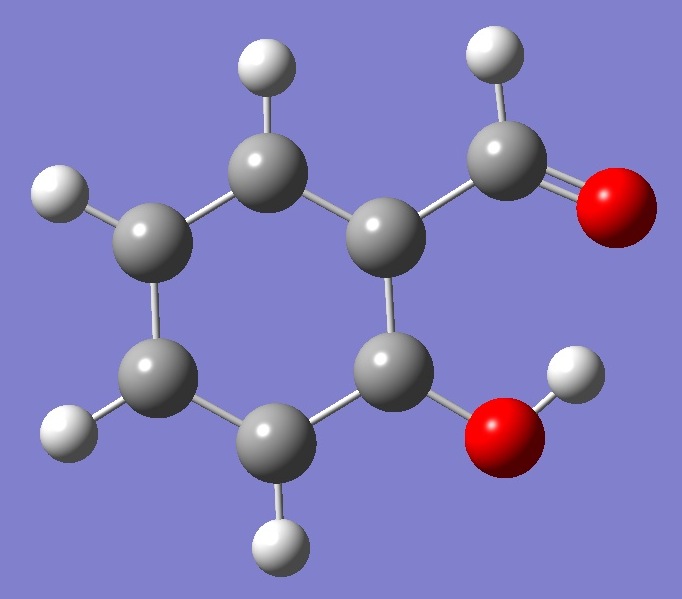|
|
|
|
|
|
|
|
|
|
|
|
|
|
|
|
|
|
|
|
|
C6H4(-CHO)(-OD)
|
|

|
|
|
|
|
|
|
|
|
|
|
|
|
|
|
|
|
|
|
|
|
|
|
|
|
|
|
|
|
|
|
|
|
|
|
|
|
|
|
|
|
|
Hydroxyl Deuterium |
|
|
|
Nuclear
Quadrupole Coupling Constants |
|
|
|
in Salicylaldehyde |
|
|
|
|
|
|
|
|
|
|
|
|
|
|
|
|
|
|
|
|
|
|
|
|
|
|
|
|
|
|
|
|
|
Calculation was made of the hydroxyl
deuterium nqcc's in salicylaldehyde on the sustitution structure of Dorosh [1].
These are compared with the experimental nqcc's [1] in Table 1. Structure parameters are given here. |
|
|
|
|
|
|
|
|
|
|
|
|
In Table 1, subscripts a,b,c refer to the principal
axes of the inertia tensor, subscripts x,y,z to the principal
axes of the nqcc tensor. The nqcc y-axis is chosen coincident with
the inertia c-axis, these are perpendicular to the plane of the molecule.
Ø (degrees) is the angle between its subscripted parameters. ETA
= (Xxx - Xyy)/Xzz. |
|
|
RMS is the root mean square
difference between calculated and experimental diagonal nqcc's.
RSD is the residual standard deviation of the B3LYP/6-31G(df,3p)
model for calculation of the nqcc's, which may be taken as an estimate
of the uncertainty in the calculated nqcc's. |
|
|
|
|
|
|
|
|
|
|
|
|
|
|
|
|
|
|
|
|
|
|
| |
|
|
|
|
|
|
|
|
Table 1. Deuterium nqcc's
in C6H4-CHO-OD (kHz). Calculation was made on the rs structure [1]. |
|
| |
|
|
|
|
|
|
|
|
|
|
|
Calc |
|
Expt [1] |
|
| |
|
|
|
|
|
|
|
|
2H |
Xaa |
|
153.0 |
|
153.5(15) |
|
|
|
Xbb |
|
- 28.9 |
|
- 30.4(21) |
|
|
|
Xcc |
- |
124.1 |
- |
123.2(21) |
|
|
|
|Xab| |
|
119.3 |
|
|
|
|
|
|
|
|
|
|
|
|
|
RMS |
|
1.1 (1.0 %) |
|
|
|
|
|
RSD |
|
1.1 (0.9 %) |
|
|
|
|
|
|
|
|
|
|
|
|
|
Xxx |
|
- 87.9 |
|
|
|
|
|
Xyy |
- |
124.1 |
|
|
|
|
|
Xzz |
|
212.1 |
|
|
|
|
|
ETA |
|
0.171 |
|
|
|
|
|
Øz,a |
|
26.34 |
|
|
|
|
|
Øa,OD |
|
29.83 |
|
|
|
|
|
Øz,OD |
|
3.49 |
|
|
|
|
|
|
|
|
|
|
|
|
|
|
|
|
|
|
|
|
|
|
|
| |
|
|
|
|
|
|
|
|
|
|
Structure parameters, rs are given here in Z-matrix format. |
|
|
|
|
|
|
|
|
|
|
|
|
|
|
|
|
|
|
|
|
|
|
[1] O.Dorosh, Doctoral
Dissertation, Institute of Physics, Polish Academy of Sciences, 2008.
Advisor: Z.Kisiel. Available online at http://info.ifpan.edu.pl/ON-2/on23.html. |
|
|
|
|
|
|
|
|
|
|
|
|
|
|
|
|
|
|
|
|
|
|
Phenol |
Benzoic Acid |
|
|
|
|
|
|
|
|
|
|
|
|
|
|
|
|
|
|
|
|
|
|
|
|
Table of Contents |
|
|
|
|
|
Molecules/Deuterium |
|
|
|
|
|
|
|
|
|
|
|
|
|
|
|
|
|
|
|
|
|
|
|
|
|
|
|
|
|
|
C6H4_CHO_OH.html |
|
|
|
|
|
|
Last
Modified 10 Nov 2008 |
|
|
|
|
|
|
|
|
|
|
